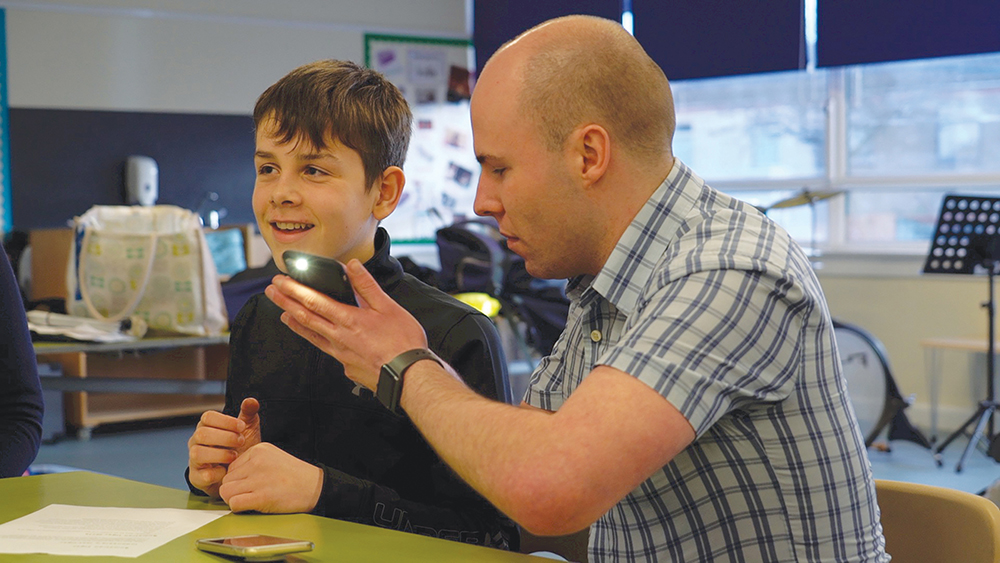So many people take technology for granted these days. But have you ever considered the impact that today’s technology advancements have meant to the visually impaired?
Stuart Beveridge is the assistive technology trainer at seescape in Fife one of the leading organisations in assisting and training people with a visual impairment. Stuart has no sight and is an enthusiast when it comes to Smart Technology, not only when training other people who are Severely Sight Impaired, but also in his everyday life, allowing him to live independently with his guide dog, Ron. Stuart is able to demonstrate, advise and train clients to use all of the devices listed in this article as well as specialist assistive technology such as Braille and screen reading software for Windows computers such as JAWS.
How can a visually impaired person possibly use one of these devices?
“Apple provide accessibility features in all of their products which can be used by people with a range of disabilities including sight loss, hearing loss, dexterity issues etc. Clients who use the Android platform such as Google, Samsung and Amazon also have a range of similar built-in accessibility features.
Whether you use products such as iPhones, iPads, Google Pixel, Samsung Galaxy or Amazon Fire, these features are right at your fingertips and can be enabled as soon as you switch your device on for the first time.
The main accessibility features provided for sight impaired people are VoiceOver (Apple), TalkBack (Google) and Voice View (Amazon). When a screen reader such as VoiceOver is turned on, the device will speak information about any item on the screen. It also reads text messages, emails, notifications and alerts when they appear.
Training to use these features is provided by the Assistive Technology Team at seescape and once mastered; a visually impaired person can use their preferred device just as well as a sighted person. The only thing that changes is the way you interact with the screen.”
Game Changer
“However, it’s not only the area of phones and tablets which are changing the lives of people with a visual impairment. The recent introduction of smart speakers such as the Amazon Echo and Google Home has taken accessibility to a whole new level.
Virtual Assistants such as Siri and Cortana which respond to audible commands have been in our phones, tablets and computers for a while, but the recent release of the standalone Amazon and Google smart speakers has been a game changer for people with a visual impairment.
These speakers are fully controlled using voice activation commands and allow the user to accomplish everyday tasks such as:
Get date time and weather information, setting alarms timers and reminders, listening to radio and news, create shopping lists, listen to audiobooks, play games, ask factual questions etc. These smart speakers can be used by anyone regardless of their technology skills. Another huge advantage of these speakers is that you have instant access to public transport timetables and information relating to departure and arrival times for public transport options such as buses and trains. This means that a lot of the stress in planning a journey is avoided.
Another area of smart technology focuses around robotic devices which perform everyday tasks such as mundane cleaning.
The best example on the market at the moment is the Dyson 360 Eye Robot Vacuum. This is a robot hoover which can be controlled either manually or via a smart device such as a phone or speaker. Many of the clients who visit seescape live by themselves and sometimes struggle to accomplish everyday tasks such as cleaning. This robot vacuum cleaner makes this task much easier for people as, once activated, it will map out the room and clean the floor of said room in its entirety avoiding any obstacles in its path. It will then move on to the next room and repeat the same process until all of the floors in either the downstairs or upstairs are cleaned. It will then return to its charger which gives the added bonus that it will be easy to locate again if needed. There are many robot vacuums of this description on the market, all claiming to do the same as the Dyson model and some are substantially cheaper. However, most of these devices are touch screen operated therefore meaning they are in most cases totally inaccessible to people with a visual impairment. The Dyson version only has one button located on the top of the device which is used to activate it and start it on the cleaning cycle.
Stuart finishes by saying: “The barriers which exist between visually impaired people and the sighted world are being broken down with each product introduced to the market. With the help of apps for navigation, travel, bar code reading for food products to gaming as well as reading your mail, controlling your heating or doing your own online banking and shopping, they are all making a difference.
The technology service the charity is providing for our clients is leading the way. We know that the future is set to bring new technology for people with sight loss and it’s hugely important that I am able to stay up to date and ahead of the game to provide the very best for our clients. In terms of current and future developments in smart technology, there has never been a more exciting time to be involved and we are only scratching the surface at present.”
If you would like to find out more about seescape please contact them on 01592 644979 or email stuart.beveridge@seescape.org.uk






